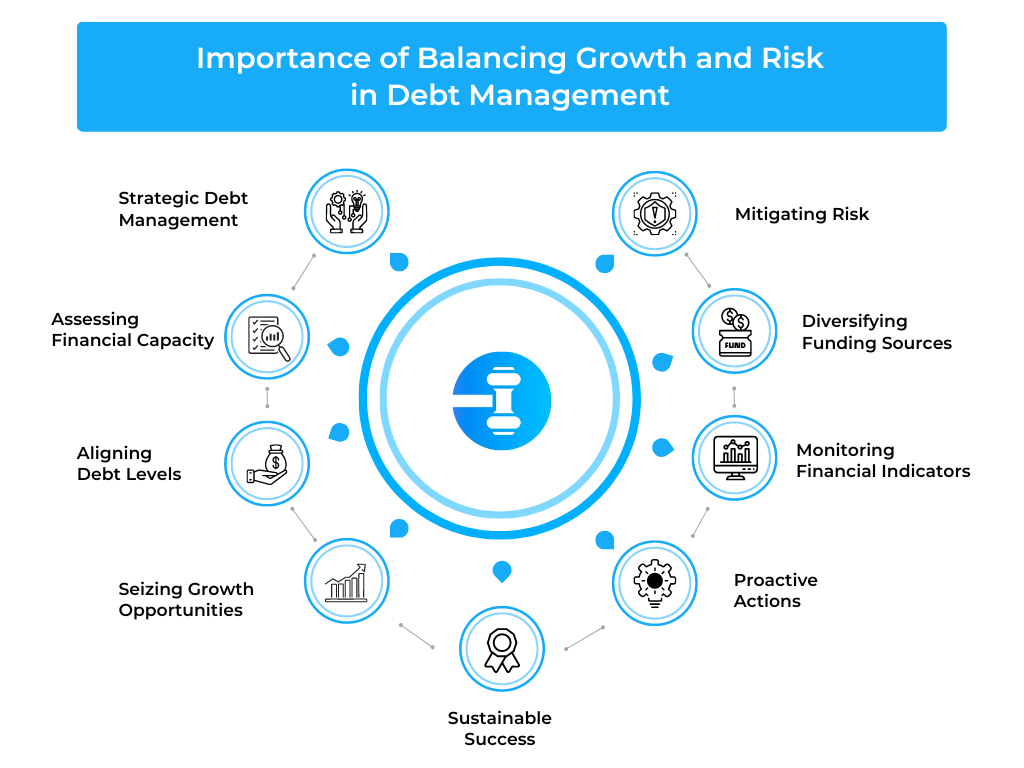Balancing growth and risk: Managing debt for revenue-based financing fintech

Debt plays a pivotal role in revenue-based financing, offering startups and small businesses access to capital while retaining ownership. It serves as a catalyst for growth, enabling businesses to invest in expansion, innovation, and market penetration. However, managing debt strategically is crucial to balance growth opportunities with potential risks. This introduction explores the significance of debt in revenue-based financing and the need for effective debt management to ensure sustainable success.
Importance of Balancing Growth and Risk in Debt Management

- Strategic Debt Management: Key role in balancing growth opportunities and risks for fintech companies.
- Assessing Financial Capacity: Evaluating the company’s financial position and capabilities. Determining the appropriate level of debt based on growth potential.
- Aligning Debt Levels: Ensuring debt levels are in line with the company’s growth objectives. Avoiding excessive debt that can lead to default risk and financial instability.
- Seizing Growth Opportunities: Debt as a tool to fuel expansion, innovation, and market penetration. Leveraging debt for strategic investments and scaling operations.
- Mitigating Risk: Conducting thorough risk assessments to identify potential risks. Incorporating risk mitigation strategies into debt management plans.
- Diversifying Funding Sources: Reducing reliance on debt by exploring alternative financing options. Spreading risk across different funding sources to enhance financial stability.
- Monitoring Financial Indicators: Regularly reviewing key financial indicators to gauge the company’s financial health. Identifying early warning signs of financial strain and taking proactive measures.
- Proactive Actions: Taking timely corrective actions to avoid defaults or liquidity challenges. Adapting debt management strategies to changing market conditions.
- Sustainable Success: Achieving a balance between growth and risk to ensure long-term success. Maintaining financial stability while pursuing growth opportunities.
Assessing debt capacity is a critical step for fintech companies to effectively plan for growth
It involves evaluating the company’s financial position, analyzing its ability to take on debt, and determining the optimal level of borrowing to support growth objectives. To assess debt capacity, fintech companies must first evaluate their financial health by analyzing key metrics such as cash flow, profitability, and liquidity. Understanding the company’s current financial position provides insights into its capacity to take on additional debt and service existing obligations. Cash flow analysis is also essential, as it helps determine the amount of cash available for debt servicing and identifies any potential shortfalls that may hinder growth plans. Additionally, assessing the debt-to-equity ratio helps determine the company’s leverage and financial risk, ensuring a balanced capital structure. The debt service coverage ratio is another crucial metric as it measures the company’s ability to meet its debt obligations. Fintech companies should consider their growth projections and expected returns on investment when assessing debt capacity, ensuring that the level of debt aligns with their growth plans and maintains financial sustainability. Conducting a comprehensive risk assessment, including stress testing under adverse scenarios, is also essential to evaluate the company’s ability to withstand challenging conditions. By carefully assessing debt capacity, fintech companies can make informed decisions about their borrowing needs and develop effective growth plans that align with their financial capabilities, mitigate risks, and maximize their potential for success.
Structuring repayment terms to align with revenue generation
Structuring repayment terms to align with revenue generation is a key aspect of effective debt management for fintech companies. By carefully designing repayment schedules that correspond to the company’s revenue generation capacity, they can ensure a sustainable and manageable debt repayment process. This involves analyzing the cash flow patterns, revenue projections, and business cycles to determine the most appropriate repayment terms. Fintech companies may opt for flexible repayment structures, such as revenue-based or performance-based repayment models, where debt payments are tied to the company’s revenue or financial performance. By aligning repayment terms with revenue generation, fintech companies can optimize cash flow, reduce financial strain, and increase the likelihood of meeting debt obligations without jeopardizing their growth plans.
Mitigating Risk: Strategies for Timely Debt Repayment
Mitigating risk is crucial in debt management for fintech companies. Strategies for timely debt repayment include maintaining a cash reserve, diversifying funding sources, and monitoring key financial indicators. Taking proactive actions, such as negotiating payment terms or implementing cost-saving measures, helps address any potential issues. Adapting debt management strategies to changing market conditions and conducting thorough risk assessments are also essential. By implementing these strategies, fintech companies can minimize risk, ensure timely debt repayment, and maintain financial stability for sustainable growth.
Diversifying Funding Sources to Reduce Dependency on Debt
Diversifying funding sources is a vital strategy for fintech companies to reduce their dependency on debt and enhance their financial stability. Relying solely on debt financing can expose companies to concentration risks and increase their vulnerability to market fluctuations. By exploring alternative financing options, such as equity investments, strategic partnerships, or government grants, fintech companies can access additional capital without solely relying on debt. Diversification of funding sources not only spreads the risk but also provides flexibility and resilience to withstand challenging economic conditions. It allows companies to tap into a broader range of resources and opportunities, enabling them to pursue growth initiatives while reducing the burden of debt repayment. Furthermore, diversification opens doors to strategic collaborations and access to industry expertise, which can bring added value beyond just financial support. Fintech companies should carefully assess and consider various funding options to create a well-rounded and diversified capital structure that aligns with their growth plans and reduces dependency on debt financing.
The Role of Risk Management in Debt-Based Growth Strategies
Effective risk management plays a pivotal role in debt-based growth strategies for fintech companies. While debt can provide the necessary capital to fuel expansion and achieve growth objectives, it also exposes companies to financial risks that need to be carefully managed. By implementing robust risk management practices, fintech companies can minimize potential pitfalls and safeguard their financial stability.
- Risk Identification: The first step in risk management is to identify and assess potential risks associated with debt-based growth strategies. This involves evaluating factors such as market volatility, regulatory changes, economic conditions, and competitive dynamics. By understanding the risks specific to their industry and business model, fintech companies can take proactive measures to mitigate them.
- Risk Mitigation Strategies: Once risks are identified, fintech companies can develop appropriate strategies to mitigate them. This may include diversifying their revenue streams, establishing contingency plans, implementing risk hedging mechanisms, or securing appropriate insurance coverage. By diversifying their customer base, product offerings, or geographic reach, companies can reduce their dependency on a single source of revenue and minimize the impact of potential risks.
- Financial Modeling and Stress Testing: Conducting comprehensive financial modeling and stress testing is essential for assessing the potential impact of adverse scenarios on debt-based growth strategies. By simulating challenging economic conditions or unforeseen events, companies can evaluate their ability to meet debt obligations and make informed decisions about their growth plans. Stress testing helps identify vulnerabilities and allows companies to implement necessary adjustments to mitigate risks.
- Debt Structure Analysis: Analyzing the debt structure is crucial in risk management. Fintech companies should carefully assess the terms and conditions of their debt, such as interest rates, repayment schedules, and covenants. Understanding the risks associated with the debt structure allows companies to evaluate their capacity to service the debt under different scenarios and consider refinancing or renegotiation if necessary.
- Regular Monitoring and Reporting: Ongoing monitoring of key financial indicators is essential to detect potential risks early on. Fintech companies should establish robust reporting mechanisms to track financial performance, cash flow, and debt service capabilities. Regular analysis of these indicators allows companies to identify deviations from expected trends and take proactive measures to mitigate risks.
- Contingency Planning: Despite diligent risk management, unforeseen circumstances can still arise. Fintech companies should have contingency plans in place to address potential risks and manage any adverse impacts on their debt-based growth strategies. This may involve building emergency reserves, establishing lines of credit, or establishing relationships with alternative funding sources.
Optimizing Growth Potential through Strategic Debt Management
In conclusion, strategic debt management is paramount for fintech companies aiming to optimize their growth potential. By carefully assessing debt capacity, aligning debt levels with growth objectives, and structuring repayment terms in line with revenue generation, these companies can effectively leverage debt as a catalyst for expansion while maintaining financial stability. Mitigating risks through proactive measures, diversifying funding sources, and monitoring key financial indicators are crucial components of successful debt management. By finding the right balance between growth opportunities and risk mitigation, fintech companies can unlock their growth potential and pave the way for sustained success in the dynamic landscape of the fintech industry.